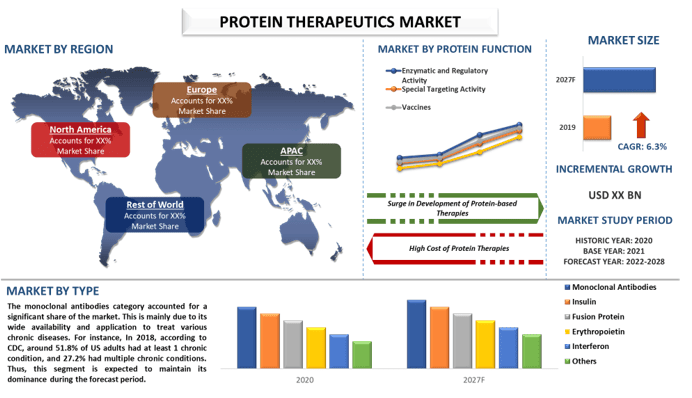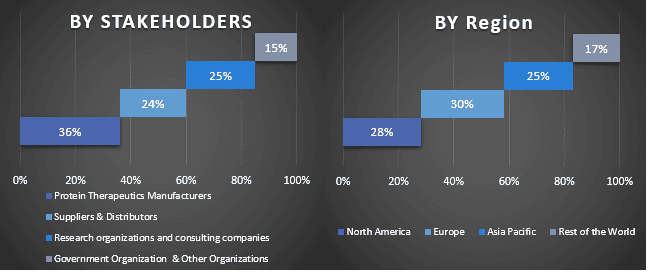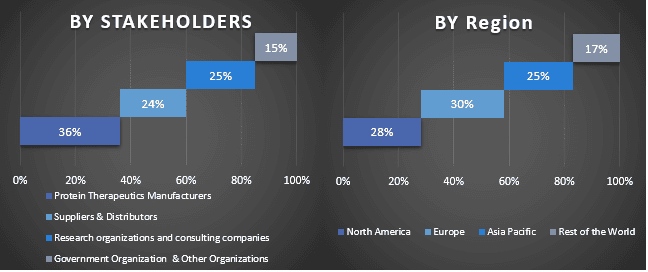Emphasis on Type (Monoclonal Antibodies, Insulin, Fusion Protein, Erythropoietin, Interferon, Others); Application (Cancer, Metabolic Disorders, Immunologic Disorders, Hematological Disorders, Others); Protein Function (Enzymatic and Regulatory Activity, Special Targeting Activity, Vaccines, Others); End User (Hospitals and Clinics, Specialty Centers, Others); and Region/Country

Global protein therapeutics market is expected to register a CAGR of around ~6.3% over the period of 2022-2028. This is mainly due to the use of therapeutic proteins for manufacturing vaccines as they provide defense against autoimmune diseases, foreign agents, and cancer is likely to promote the market. Also, Protein therapeutics have stringent government regulations coupled with the growing focus of major stakeholders in the healthcare industry to adopt to make protein therapeutics products more sustainable with fewer side effects and cost-effective. Major pharmaceutical companies are investing heavily in their products due to the rising prevalence of chronic diseases, and the growing geriatric population. According to Union for International Cancer Control (UICC), the world’s population is aging rapidly, with 703 million people worldwide above the age of 65 years, representing 9.1% of the global population. Furthermore, Population aging will have consequences for cancer control globally as cancer is more prevalent in older adults. In addition, protein therapy is similar to gene therapy, which involves protein delivery in specific amounts to the body to facilitate the precise functioning of different glands and other organs in the body. Moreover, growth in proteomic research is expected to lead to an increase in the emergence of new protein drugs and drugs that have the potential to significantly improve human health which drives the market. Therefore, the market for protein therapeutics is expected to witness significant growth during the forecast period.
Abbott Laboratories, Amgen Inc., Baxter International Inc., Eli Lilly and Company, F. Hoffmann La Roche Ltd, Johnson and Johnson, Merck and Co., Inc., Novo Nordisk AS, Pfizer Inc., Sanofi are some of the key players in the market. Several M&As along with partnerships have been undertaken by these players to facilitate customers with hi-tech and innovative products/technologies.
Insights Presented in the Report
“Amongst application, metabolic disorders are expected to witness significant CAGR during the forecast period”
Based on application, the market is categorized into cancer, metabolic disorders, immunologic disorders, hematological disorders, and others. Among these, metabolic disorders are expected to witness a significant CAGR during the forecast period. This is mainly due to the requirement for quality drugs and versatile therapies for disease treatment, especially coronary heart disease, diabetes, and stroke which is expected to boost the growth of this segment. According to the American Heart Association, 47 million Americans have it. That’s almost a staggering 1 out of every 6 people in 2021. Therefore, this segment rising due to the use of protein therapeutics in the global market is likely to boost the demand for protein therapeutics.
“Amongst protein function, enzymatic and regulatory activity category accounted for the significant share in the market in 2020”
Based on protein function, the market is classified into enzymatic and regulatory activity, special targeting activity, vaccines, and others. Amongst protein functions, the enzymatic and regulatory activity category accounted for a significant share of the market. Based on their pharmacological activity, they can be divided into five groups: (a) replacing a protein that is deficient or abnormal; (b) augmenting an existing pathway; (c) providing a novel function or activity; (d) interfering with a molecule or organism; and (e) delivering other compounds or proteins, such as a radionuclide, cytotoxic drug, or effector protein.
“Amongst end-user, hospitals and clinics category accounted for the significant share in the market in 2020”
Based on end-user, the market is categorized into hospitals and clinics, specialty centers, and others. Among these, hospitals and clinics are expected to witness the highest CAGR during the forecast period. The hospitals and clinics are estimated to add to the growing need for protein therapeutics products which is expected to drive the growth of this segment. Also, the use of therapeutic proteins for manufacturing vaccines as they provide defense against autoimmune diseases, foreign agents, and cancer is likely to promote the market. For instance, In June 2022, Pfizer and BioNTech Announce Omicron-Adapted COVID-19 Vaccine Candidates Demonstrate High Immune Response Against Omicron
“North America to witness significant growth during the forecast period”
North America is expected to show the highest CAGR growth in the protein therapeutics market. The major contributors to the growth of this market are US and Canada. This is mainly due to the growing various protein therapeutics and highly developed economy, high product adoption rates, awareness about protein-based therapeutics, and surge in strategic developments among key players of the market in the U.S. economy. For instance, In July 2020, Kymera Therapeutics Inc. announced the company has entered into a multi-program strategic collaboration with Sanofi (NASDAQ: SNY) to develop and commercialize first-in-class protein degrader therapies targeting IRAK4 in patients with immune-inflammatory diseases. Moreover, the development of advanced protein therapeutics by major companies and the diagnostics industry owing to the presence of well-established market players and frequent product launches in the region.
Reasons to buy this report:
Customization Options:
Global protein therapeutics market can further be customized as per the requirement or any other market segment. Besides this, UMI understands that you may have your own business needs, hence feel free to connect with us to get a report that completely suits your requirements.
1. Market Introduction
2. Research Methodology Or Assumption
3. Market Synopsis
4. Executive Summary
5. Global Protein Therapeutics Market Covid-19 Impact
6. Global Protein Therapeutics Market Revenue (usd Bn), 2019-2027f
7. Market Insights By Type
8. Market Insights By Application
9. Market Insights By Protein Function
10. Market Insights By End-user
11. Market Insights By Region
12. Protein Therapeutics Market Dynamics
13. Protein Therapeutics Market Opportunities
14. Protein Therapeutics Market Trends
15. Policy & Regulatory Framework
16. Demand And Supply-side Analysis
17. Value Chain Analysis
18. Competitive Scenario
19. Company Profiled
20. Disclaimer
Research Methodology for the Global Protein Therapeutics Market Analysis (2022-2028)
Analyzing the historical market, estimation of the current market, and forecasting the future market of the global protein therapeutics market were the three major steps undertaken to create and analyze the adoption of protein therapeutics in major regions globally. Exhaustive secondary research was conducted to collect the historical market numbers and estimate the current market size. Secondly, to validate these insights, numerous findings and assumptions were taken into consideration. Moreover, exhaustive primary interviews were also conducted, with industry experts across the value chain of the global protein therapeutics market. Post assumption and validation of market numbers through primary interviews, we employed a top-down/bottom-up approach to forecasting the complete market size. Thereafter, market breakdown and data triangulation methods were adopted to estimate and analyze the market size of segments and sub-segments of the industry pertains to. Detailed methodology is explained below:
Analysis of Historical Market Size
Step 1: In-Depth Study of Secondary Sources:
Detail secondary study was conducted to obtain the historical market size of the protein therapeutics market through company internal sources such as annual reports & financial statements, performance presentations, press releases, etc., and external sources including journals, news & articles, government publications, competitor publications, sector reports, third-party database, and other credible publications.
Step 2: Market Segmentation:
After obtaining the historical market size of the protein therapeutics market, we conducted a detailed secondary analysis to gather historical market insights and share for different segments & sub-segments for major regions. Major segments are included in the report as type, application, protein function, end user, and region. Further country-level analyses were conducted to evaluate the overall adoption of testing models in that region.
Step 3: Factor Analysis:
After acquiring the historical market size of different segments and sub-segments, we conducted a detailed factor analysis to estimate the current market size of the protein therapeutics market. Further, we conducted factor analysis using dependent and independent variables such as the type, application, protein function, end user, and region of protein therapeutics. A thorough analysis was conducted for demand and supply-side scenarios considering top partnerships, mergers and acquisitions, business expansion, and product launches in the protein therapeutics market sector across the globe.
Current Market Size Estimate & Forecast
Current Market Sizing: Based on actionable insights from the above 3 steps, we arrived at the current market size, key players in the global protein therapeutics market, and market shares of the segments. All the required percentage shares split, and market breakdowns were determined using the above-mentioned secondary approach and were verified through primary interviews.
Estimation & Forecasting: For market estimation and forecast, weights were assigned to different factors including drivers & trends, restraints, and opportunities available for the stakeholders. After analyzing these factors, relevant forecasting techniques i.e., top-down/bottom-up approach were applied to arrive at the market forecast about 2028 for different segments and sub-segments across the major markets globally. The research methodology adopted to estimate the market size encompasses:
Market Size and Share Validation
Primary Research: In-depth interviews were conducted with the Key Opinion Leaders (KOLs) including Top Level Executives (CXO/VPs, Sales Head, Marketing Head, Operational Head, Regional Head, Country Head, etc.) across major regions. Primary research findings were then summarized, and statistical analysis was performed to prove the stated hypothesis. Inputs from primary research were consolidated with secondary findings, hence turning information into actionable insights.
Split of Primary Participants in Different Regions

Market Engineering
Data triangulation technique was employed to complete the overall market estimation and to arrive at precise statistical numbers for each segment and sub-segment of the global protein therapeutics market. Data was split into several segments & sub-segments post studying various parameters and trends in the areas of type, application, protein function, end user, and region, and region in the global protein therapeutics market.
The main objective of the Global Protein therapeutics Market Study
The current & future market trends of the global protein therapeutics market were pinpointed in the study. Investors can gain strategic insights to base their discretion for investments on the qualitative and quantitative analysis performed in the study. Current and future market trends determined the overall attractiveness of the market at a regional level, providing a platform for the industrial participant to exploit the untapped market to benefit from a first-mover advantage. Other quantitative goals of the studies include:

Customers who bought this item also bought